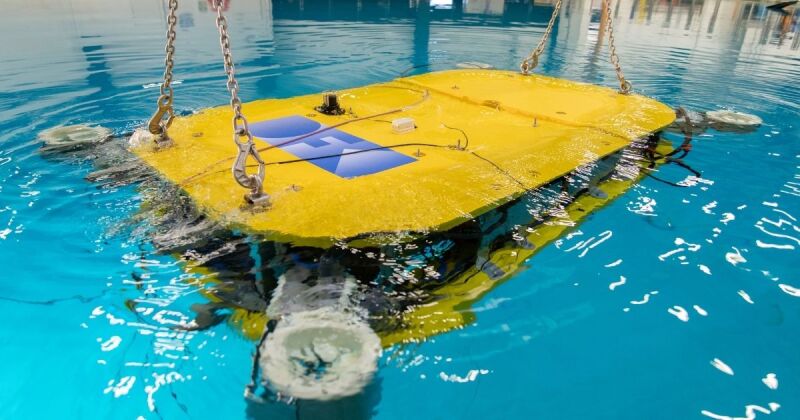Autonomous underwater vehicles (AUVs), operated and controlled by artificial intelligence (AI) methods, inspect, maintain, and repair offshore installations under water.
A consortium led by the German Research Center for Artificial Intelligence (DFKI) developed a holistic solution in the Mare-IT project to make this vision a reality: an innovative, two-armed AUV for complex inspection and maintenance tasks, embedded in a powerful IT infrastructure that enables both intuitive control and monitoring of the system and effective information flow with the plant operator. The project was funded by the German Federal Ministry of Education and Research (BMBF).
To ensure the safety of offshore infrastructure such as wind turbines or oil and gas production facilities, regular inspection and maintenance is essential. However, the work carried out under water not only is complex and expensive but also involves considerable risks for the divers who perform it. Remotely operated underwater systems (ROVs) are already being used to monitor the condition of maritime assets. However, there is a tendency toward systems that remain in the water for long periods of time—so-called subsea resident AUVs—and operate there autonomously and at the same time can be remotely controlled if necessary.
An important step in this direction has been taken by a consortium of leading companies and research institutions from the fields of IT, robotics, drive technology, and offshore under the leadership of the DFKI Robotics Innovation Center in the Mare-IT project. At the end of the project, the partners presented a holistic solution. This consists of a novel two-arm AUV that can operate both autonomously and remotely and, thanks to two integrated manipulators, can be used for maintenance work and repairs on underwater structures. In addition, the partners are providing a powerful IT infrastructure that not only enables intuitive control and monitoring of the robot under water but also ensures the smooth bidirectional flow of information with the plant operators and allows integration into existing business processes.
"With Mare-IT, we were once again able to demonstrate that the development of autonomous robots for complex underwater applications cannot be implemented without machine-learning and artificial-intelligence methods," said Frank Kirchner, director of the DFKI Robotics Innovation Center. "Our research represents an important building block in making the vision of practical autonomous underwater vehicles in the offshore industry a reality. We are delighted that we were able to successfully complete the project, also thanks to the very good cooperation with our strong partners, despite the difficult conditions caused by the Corona pandemic.”
The DFKI Robotics Innovation Center has successfully designed and built the AUV Cuttlefish in Mare-IT as an intervention AUV that can be freely positioned in the water column. The innovative AUV has two deepsea gripping systems attached to its ventral side that allow it to manipulate objects under water. In doing so, thanks to its special design and AI-based control, it is possible to change the center of gravity and buoyancy during a dive and to adopt and maintain any orientation in a stable manner. In addition to fully autonomous operations, the vehicle can be operated in a hybrid mode—so-called supervised autonomy—using a fiber-optic cable. The hybrid mode allows humans to intervene and remotely control the AUV during critical operations on underwater structures. For this purpose, in addition to the manipulators, the system is equipped with many sensors for environmental perception (e.g., sonar sensors, cameras, laser scanners, and magnetometers).
To effectively process the large amount of sensor data, the researchers developed a special architecture concept that enables the decentralized analysis of data streams directly on board the robot. The researchers in Bremen were also responsible for implementing mission planning to carry out inspection or maintenance tasks. In addition, they developed a standard interface that enables bidirectional data exchange between the AUV, the control station, and the internal business infrastructure.

